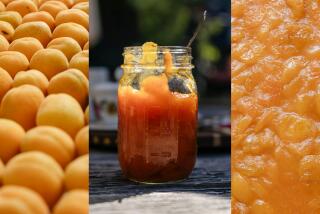Such a Fragile Pleasure: An Apricot Worth the Wait
- Share via
Apricots have been available in stores since late April, but real aficionados have been waiting for the locally grown Blenheims, which are just now ripening and will be around for another few weeks.
The Blenheim has every possible commercial flaw: It’s smaller and less highly colored than modern varieties. When picked ripe, it’s too perishable to ship. And its delicate insides turn to mush in the brutal heat of the San Joaquin Valley, where most apricots are grown today.
There’s only one reason it’s so beloved: flavor. Bite into a ripe Blenheim, whether pale yellow-orange, or deeper orange with a freckled, rosy blush, and the juice explodes in your mouth (and will dribble onto your shirt if you’re not careful). The luscious flesh is honey-sweet, balanced by a tinge of acidity in specimens that are not overripe. Most vitally, the Blenheim has a sensual perfume, a mysterious complexity lacking in even the best modern varieties.
The nomenclature of the Blenheim and its sister variety, the Royal, is much confused. The Blenheim was originally called Shipley’s, because it was raised from a seed sown by a Miss Shipley, the daughter of a gardener to the Duke of Marlborough at Blenheim Palace in England before 1830. The Royal arose from a seed of the Peche de Nancy apricot planted in 1808 by the director of the Luxembourg Garden in Paris; it was so named because King Louis XVIII found it supremely delicious.
In the late 19th century the Royal and the Blenheim were grown as distinct varieties, but by 1920 they were sold indiscriminately by many California nurseries, and today many farmers call them both Royal Blenheim. Connoisseurs say that the Blenheim is a bit larger and has a rounder stone, while the Royal is slightly flattened, almost wedge-shaped, but it’s a distinction that’s hardly worth worrying over. Both ripen from the inside out, so that even pale fruits can be explosively juicy and flavorful.
In the early 20th century the Southland produced a third of California’s apricot crop, but the trees were not as productive as those grown elsewhere, and with the added pressure of development, commercial cultivation has almost disappeared in these parts. It’s still possible to grow your own tree, of course, though that means battling the squirrels that delight in biting the sweetest parts of every ripe fruit before you can pick them.
It’s easier to buy from the few remaining growers, which also encourages them to keep growing this finicky crop. Show up early at farmers markets, before the fruits are pawed over, and bring a flat box so that they don’t get squished on the way home. They cost about $2 a pound; a small price for such pleasure.
*
(BEGIN TEXT OF INFOBOX)
Where to Get Blenheims
Here are some sources for Blenheim apricots:
Cirone Farms. At Santa Monica (Wednesday and Saturday Organic) and Hollywood farmers markets for a few weeks.
Forcefield Farm. At Santa Monica (Wednesday) and Thousand Oaks farmers markets for the next week or so.
Ira Grooms. At Camarillo and Ventura (Victoria) farmers markets, for several weeks starting about July 6.
K.B. Hall Ranch. Organic. At farm stand, open Friday and Saturday for the next week or two, 11999 Ojai-Santa Paula Road, Ojai; and at Santa Monica (Wednesday) farmers market.
Savala Ranch. At farm stand for the next week or so. Open 9 a.m. to 6 p.m. daily. 1977 S. Hewitt St., San Jacinto; (909) 658-2426.
Tierra Rejada Family Farms. Pick your own, through about July 7. 65 cents a pound. Open 9 a.m. to 6 p.m. daily. 3370 Moorpark Road, Moorpark; (805) 529-3690.
*
FARMERS MARKETS:
Camarillo (2220 Ventura Blvd.), 8 a.m. to noon Saturday.
Hollywood (Ivar Avenue between Sunset and Hollywood boulevards), 8:30 a.m. to 1 p.m. Sunday.
Santa Monica (Arizona Avenue and 2nd Street), 9 a.m. to 2 p.m. Wednesday, 8:30 a.m. to 1 p.m. Saturday.
Thousand Oaks (Wilbur Road and Thousand Oaks Boulevard), 3 to 7 p.m. Thursday.
Ventura (Telephone Road east of Victoria Avenue), 10 a.m. to 2 p.m. Sunday.
More to Read
Sign up for The Wild
We’ll help you find the best places to hike, bike and run, as well as the perfect silent spots for meditation and yoga.
You may occasionally receive promotional content from the Los Angeles Times.






